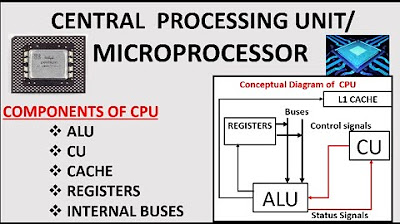The Bus | How the computer works?
Summary
TLDRThis script explores the evolution of computer buses, the pathways that transmit information between components. It contrasts the parallel bus, which uses multiple lanes for data transfer and is prevalent in RAM and PCI devices, with the serial bus, which sends data bit by bit and is gaining popularity due to its simplicity and improved signal integrity. The script also delves into the historical development from the system bus to the chipset architecture, highlighting the importance of buses in creating a unified and efficient computing environment.
Takeaways
- 💻 Computers are digital systems where various devices work together as one unit, using pathways to transmit information between components.
- 🔌 Early computers had parts like the CPU and RAM in separate cabinets, with information traveling between them via bundles of wires known as a bus bar.
- 🛤️ There are two main designs of the computer bus: parallel and serial, each with its own method of data transmission.
- 🔁 A parallel bus uses multiple lanes to transmit information, breaking data into smaller pieces sent across each lane, which is efficient for memory address transmission.
- 🔄 To accommodate the need for smaller devices, multiplexers were used to transmit data in halves over two clock cycles, improving processing power while keeping circuit size small.
- 🔗 Parallel buses are the dominant mode for transmitting information within computer components like RAM and PCI, connected devices all use parallel buses for communication with the CPU.
- 🚀 The dominance of parallel buses may decline due to the rise of serial buses, which transmit information one bit at a time across a single lane.
- 🌐 Initially slower than parallel buses, serial buses are gaining popularity due to improved signal integrity, transmission speeds, and lower susceptibility to electromagnetic interference.
- 🔌 Serial buses are now common in connections like PCI Express, USB, and SATA, and their usage is expected to grow.
- 📈 The evolution of computer bus design has transitioned from bundles of wires to integrated connections within microprocessors and computer motherboards.
- 🔄 Before the 1980s, the system bus performed multiple functions including data, address, and control operations, but has since been phased out for more efficient architectures.
- 🌉 The Northbridge and Southbridge, or chipset, arrangement prioritized certain components, with the Northbridge connected directly to the CPU and the Southbridge handling slower connections.
Q & A
What is the primary function of a computer bus?
-A computer bus serves as a pathway to transmit information between various components within a computer, allowing them to function as a unified system.
How did early computers transmit information between components before the advent of integrated circuits?
-In the early days of computing, information traveled between separate cabinets containing components like the CPU and RAM through bundles of wires known as a bus bar.
What are the two main designs of a computer bus?
-The two main designs of a computer bus are parallel and serial. A parallel bus uses multiple lanes to transmit information, while a serial bus transmits data one bit at a time across a single lane.
How does the number of lanes in a parallel bus affect its data transmission capabilities?
-The number of lanes in a parallel bus determines the amount of data that can be transmitted simultaneously. More lanes allow for greater bandwidth and faster data transmission.
Why were multiplexers implemented in parallel bus designs?
-Multiplexers were implemented to divide data, such as a 32-bit address, into smaller parts that could be transmitted over fewer lanes, thus keeping the circuit size manageable and improving processing power.
What are some common components and devices that use parallel buses for communication with the CPU?
-Components like RAM and PCI-connected devices typically use parallel buses for communication with the CPU.
What is the advantage of a serial bus over a parallel bus in terms of cost and physical space?
-A serial bus is advantageous because it requires fewer wires, making it less expensive to implement and less physically demanding in terms of space.
How have advancements in signal integrity and transmission speeds affected the use of serial buses?
-As signal integrity and transmission speeds have improved, serial buses have become more viable for short-range communication, which was previously dominated by parallel buses.
What are some modern connections that use serial buses?
-Modern connections that use serial buses include PCI Express, USB, and SATA.
What was the purpose of the system bus in early computer architecture?
-The system bus in early computer architecture served three functions: data transmission, address for locating specific locations within memory, and control operations such as reading and writing.
What is the role of the Northbridge and Southbridge in a computer's chipset?
-The Northbridge, connected to the CPU by the frontside bus, handles high-speed components like RAM and video cards. The Southbridge manages slower or lower-priority connections such as USB, SATA, and Ethernet.
Outlines

This section is available to paid users only. Please upgrade to access this part.
Upgrade NowMindmap

This section is available to paid users only. Please upgrade to access this part.
Upgrade NowKeywords

This section is available to paid users only. Please upgrade to access this part.
Upgrade NowHighlights

This section is available to paid users only. Please upgrade to access this part.
Upgrade NowTranscripts

This section is available to paid users only. Please upgrade to access this part.
Upgrade NowBrowse More Related Video
5.0 / 5 (0 votes)





